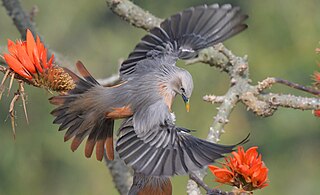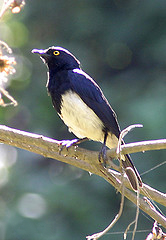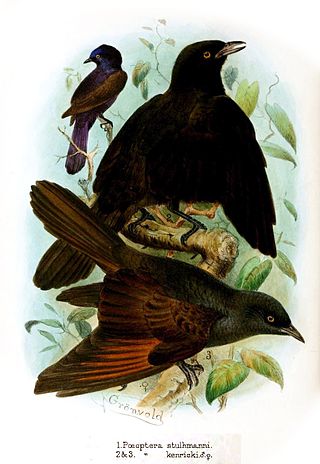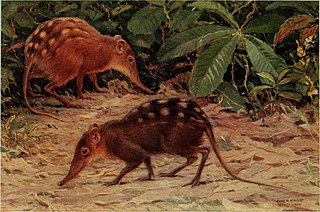
Starlings are small to medium-sized passerine birds in the family Sturnidae, common name of Sturnid. The Sturnidae are named for the genus Sturnus, which in turn comes from the Latin word for starling, sturnus. The family contains 128 species which are divided into 36 genera. Many Asian species, particularly the larger ones, are called mynas, and many African species are known as glossy starlings because of their iridescent plumage. Starlings are native to Europe, Asia, and Africa, as well as northern Australia and the islands of the tropical Pacific. Several European and Asian species have been introduced to these areas, as well as North America, Hawaii, and New Zealand, where they generally compete for habitats with native birds and are considered to be invasive species. The starling species familiar to most people in Europe and North America is the common starling, and throughout much of Asia and the Pacific, the common myna is indeed common.

The common starling, also known as the European starling in North America and simply as the starling in Great Britain and Ireland, is a medium-sized passerine bird in the starling family, Sturnidae. It is about 20 cm (8 in) long and has glossy black plumage with a metallic sheen, which is speckled with white at some times of the year. The legs are pink and the bill is black in winter and yellow in summer; young birds have browner plumage than the adults. It is a noisy bird, especially in communal roosts and other gregarious situations, with an unmusical but varied song. Its gift for mimicry has been noted in literature including the Mabinogion and the works of Pliny the Elder and William Shakespeare.

Stresemann's bushcrow, also known as the Abyssinian pie, bush crow, Ethiopian bushcrow, or by its generic name Zavattariornis, is a rather starling-like bird, which is a member of the crow family, Corvidae. It is slightly larger than the North American blue jay and is a bluish-grey in overall colour which becomes almost white on the forehead. The throat and chest are creamy-white with the tail and wings a glossy black. The black feathers have a tendency to bleach to brown at their tips. The iris of the bird is brown and the eye is surrounded by a band of naked bright blue skin. The bill, legs, and feet are black.

The brahminy starling or brahminy myna is a member of the starling family of birds. It is usually seen in pairs or small flocks in open habitats on the plains of the Indian subcontinent.

The chestnut-tailed starling, also called grey-headed starling and grey-headed myna is a member of the starling family. It is a resident or partially migratory species found in wooded habitats in India and Southeast Asia. The species name is after the distribution of a former subspecies in the Malabar region. While the chestnut-tailed starling is a winter visitor to peninsular India, the closely related resident breeding population with a white head is now treated as a full species, the Malabar starling.

The long-tailed glossy starling is a member of the starling family of birds. It is a resident breeder in tropical Africa from Senegal east to Sudan.

The superb starling is a member of the starling family of birds. It was formerly known as Spreo superbus. They are long-lived birds that can live over 15 years in captivity.

The metallic starling, also known as the shining starling, is a bird in the starling family native to the Moluccas, New Guinea, Queensland and the Solomon Islands.

The white-headed buffalo weaver or white-faced buffalo-weaver is a species of passerine bird in the family Ploceidae native to East Africa. The buffalo part of its name derives from its habit of following the African buffalo, feeding on disturbed insects. Two subspecies are recognized.

The emerald starling is also known as the iris glossy starling. It is a small starling with a metallic green crown, upper body, wings and tail. The ear-coverts and underparts are metallic purple. Both sexes are similar. Most taxonomists unite it with many other glossy starlings in Lamprotornis, while others place it in a monotypic genus Coccycolius.

The fairy martin is a member of the swallow family of passerine birds which breeds in Australia. It is migratory wintering through most of Australia, with some birds reaching New Guinea and Indonesia. It is increasingly a wanderer to New Zealand, where it may have bred. This species is frequently placed in the genus Hirundo as Hirundo ariel.

The wattled starling is a nomadic resident bird in eastern and southern Africa. It is a species of grassland, open woodland, and cultivation.

The greater blue-eared starling or greater blue-eared glossy-starling is a bird that breeds from Senegal east to Ethiopia and south through eastern Africa to northeastern South Africa and Angola. It is a very common species of open woodland bird, and undertakes some seasonal migration.

The long-tailed starling is a species of starling in the family Sturnidae. It is endemic to the Schouten Islands off West Papua, in Indonesia, an important area of bird endemism. The species was once treated as part of a superspecies with the shining starling. There are two subspecies, the nominate race, which occurs on Biak, and brevicauda, which is found on Numfor Island. It occurs in a wide range of habitats at all altitudes, including natural forest and forest edges, as well as human modified secondary forests and gardens. In spite of its tiny global range the species is not considered threatened by human activities and remains common within its range, and is therefore listed as least concern by the IUCN.

Abbott's starling is a species of starling in the family Sturnidae. It is found in Kenya and Tanzania. Its natural habitat is subtropical or tropical moist montane forests. It is threatened by habitat loss, and its population is estimated at 2500–9999. This species, at 16 to 18 cm long, is the smallest species of starling. It is in the monotypic genus Arizelopsar.

The Cape starling, also known as red-shouldered glossy-starling or Cape glossy starling, is a species of starling in the family Sturnidae. It is found in Southern Africa, where it lives in woodlands, bushveld and in suburbs.

Kenrick's starling is a species of starling in the family Sturnidae. It is found in Kenya and Tanzania.

The narrow-tailed starling is a species of starling in the family Sturnidae. It is found in West and Central Africa from Sierra Leone to the Democratic Republic of the Congo.

Stuhlmann's starling is a species of starling in the family Sturnidae. It is found in Burundi, the Democratic Republic of the Congo, Ethiopia, Kenya, Rwanda, South Sudan, Tanzania, and Uganda. Their length is usually around 19 cm, and they feed on seed, grain, arthropods and larvae.

The Stuhlmann's sengi or white-tailed sengi is a species of elephant shrew that lives in the forests and savannas of Africa. It was discovered in 1893 and declared a new species. In the 1960s, however, it was downgraded to a subspecies of checkered sengi. In 2018, following genetic tests, scientists re-evaluated the mammal as a full species again.




















